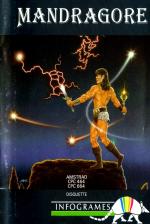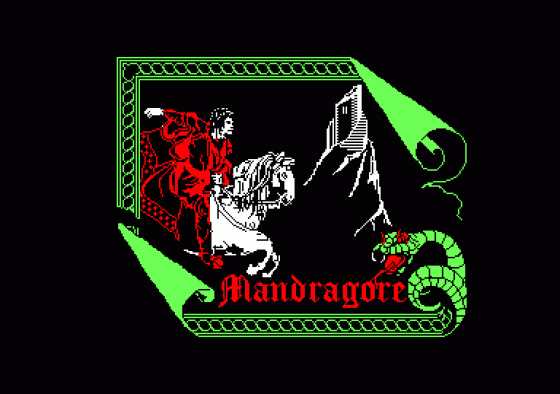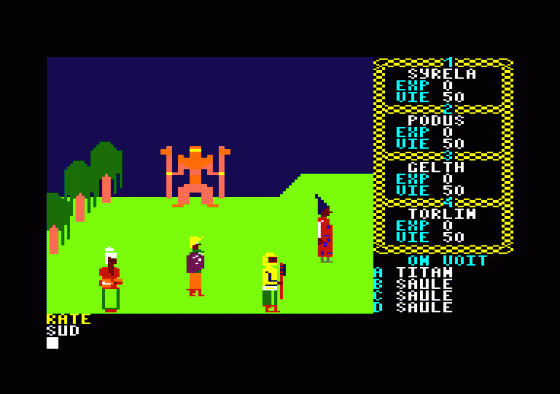
Computer Gamer
 1st July 1986
1st July 1986
Categories: Review: Software
Publisher: Infogrames
Machine: Amstrad CPC464
Published in Computer Gamer #16
Mandragore
The land was thriving under the benevolent reign of King Jorian when tragedy struck and he was killed in a freak accident. The peace that had lasted for ages was suddenly shattered as Lord Yarod-Nor appeared from nowhere to impose a reign of evil and tyranny upon the country. As it was impossible to form an army under the present regime, it was decided to try to confront and destroy Yarod-Nor in his own castle and so free the land of Mandragore.
The party that is chosen for this onerous task can consist of no more than four characters and you have the choice of using the party that described in the accompanying story or creating your own group of potential heroes. Using the established group for a quick exploration of the game is a good way of finding out how the game works, but you will soon be under the impressions that you can do better with your own hand-picked men or women. If this is so, I would strongly recommend that you save your new party as soon as it is formed so that you don't have to go through the set up procedure all over again when your party dies (a very frequent occurence!).
In order to establish a character, you must determine its race, occupation and attributes. There are five different races to choose from - human, elf, dwarf, hobbit and something called a mi-orc, although my pre-production instructions did not make clear what the differences between the various life forms were. You must assign 80 points to the six assorted attributes of strength, intelligence, wisdom, constitution, dexterity and appearance. None of these characteristics can be more than twenty or less than five. Your choice of career for your character is to some extent dictated by the values of the attributes that you have assigned. Anyone can be a warrior, but a ranger must have high strength, a wizard high intelligence and a wiseman high wisdom. High dexterity is essential for a thief whilst a mistrel must excel in charm. Finally, you must decide on the sex of your character and name him or her. You can also select the colour scheme of that person's graphic display.

Before you can defeat the evil Yarod-Nor, you must explore nine other chateaux (What gives you the impression that this game was written in France?), each one containing a problem to be solved that wil give you a clue in later parts of the game. The display is a map of the land featuring several different terrain types. You move your party around the map until you come to a castle that you want to enter, whereupon you must load in details of that castle separately. As you wander round, you are quite likely to get involved in encounters with assorted wandering monsters. There are also villages where you can sell your treasures and buy food, weapons and other useful items such as a boat.
Once inside a castle, the picture changes to a display of your current location, together with any object present. There can be up to four objects in any given room and these can range from monsters to treasure to food to furniture etc. Each of your characters (or at least those still alive!) are shown individually and you can command each one independently of the others. Commands are entered in an unusual abbreviated form that takes some getting used to, but once mastered allows you to give instructions fairly quickly.
Your party members are numbered from 1 to 4 whilst the objects are designated A to D. There are 29 different actions which are abbreviated to one or two letter commands and the general format of the command is Character - action - object. For example, if your first character was called Bongo and you wanted him to break some bars (object A) you would enter 1 BR A. The screen will then display "Bongo breaks bars" and you will see your character move up to the bars as he attempts to break them (There is no guarantee of success). There is no animation or anything when these actions are carried out; it just gives you an idea of what is going on.

Experience points are awarded for successful actions such as picking up treasure, opening a door or killing a monster, and when a character reaches 1,000 experience points, he moves up a skill level. Not everything is rosy however. Each character only has a certain amount of energy and actions such as moving round, being hit by an opponent and unsuccessful manoeuvres soon deplete your stock. Eating food is essential as it replenishes your strength again. Should your energy reach zero, you die. Balancing food and money is an essential part of the game.
There is a considerable amount of fighting to be done if you are to succeed in your quest. Amongst the creatures to be faced are the familiar such as ghosts, cyclops, chimera and witches as well as the less familiar such as bronxos, tickels, glueys, rapacs and morbidos. Some can be fought with weapons, others with magic. You usually have to defeat any monsters present bfore you can explore further. Then it's usually up to your thief as he tries to disable traps, and pick locks, etc. It is important to distinguish between the responses 'impossible action' which means that that particular character cannot perform that action (although another may be able to) and 'attempt aborted' which means that, for example, your thief tried to disarm a trap but failed.
Mandragore is a strange game that doesn't really fit into any category, being neither pure adventure, arcade adventure or role-playing. Certainly, it will keep you quiet for some time - the first person to solve it in France took five months at an average of two hours a night before he cracked it! My only worry is that it looks graphically poor and the command structure takes some getting used to... but for anyone willing to put up with that, there is a very good game inside waiting to be played.
Other Reviews Of Mandragore For The Amstrad CPC464
Mandragore (Infogrames)
A review by The Pilgrim (Amstrad Action)
Scores
Amstrad CPC464 Version| Originality | 80% |
| Graphics | 40% |
| Use Of Machine | 60% |
| Value For Money | 80% |
| Overall | 65% |




